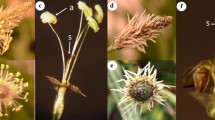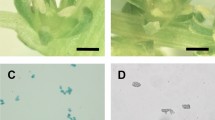Abstract
Floral development and morphology were observed for two homeotic cytoplasmic male sterile carrot lines and their isonuclear fertile maintainers. For one sterile line, W33A stamens are replaced by petal-like organs; for the other, W259A, both stamens and petals are replaced by green bract-like structures. Both isonuclear maintainers, W33B and W259B respectively, have stamens and white petals. The different sterile phenotypes result from the interactions of distinct nuclear genotypes with one sterility-inducing cytoplasm. Early stages of floral development were similar among all four lines; the third whorl primordia were radial while those in the second whorl were dorsiventral. However, the third whorl primordia were splayed outward in the sterile lines and inward in the fertile lines. Subsequently, radial anthers on filaments differentiated in fertile lines and dorsiventral hastate and cordate shaped structures appeared in W33A and W259A, respectively. In the mature flower, the third whorl organs were cordate in W33A and ovate in W259A. Based on epidermal cell morphology, the second whorl organs of the two sterile lines had characteristics of both petals and bracts, but of opposite degrees; cells of W33A and W259A were most similar to those of petals and bracts, respectively. The third whorl organs of the sterile lines had characteristics of their respective second whorl organs; however, structures of W33A also had filament-like cells and those of W259A were more bract-like than their respective second whorl organs. The cytoplasm affected when homeosis was manifested during development. Nuclear factors interacting with cytoplasm were most important for determining differentiation. The significance of cytoplasm to current models of nuclear-gene-controlled homeosis is discussed.
Similar content being viewed by others
References
Bonnet HT, Kofer W, Håkansson G, Glimelius K (1991) Mitochondrial involvement in petal and stamen development studied by sexual and somatic hybridization of Nicotiana species. Plant Sci 80:119–130
Borthwick HA, Phillips M, Robbins WW (1931) Floral development in Daucus carota. Am J Bot 18:784–796
Bowman JL, Smyth DR, Meyerowitz EM (1989) Genes directing flower development in Arabidopsis. Plant Cell 1:37–52
Bowman JL, Smyth DR, Meyerowitz EM (1991) Genetic interactions among floral homeotic genes of Arabidopsis. Development 112:1–20
Chaudhury AM, Craig S, Bloemer KC, Farrell L, Dennis ES (1992) Genetic control of male fertility in higher plants. Aust J Plant Physiol 19:419–426
Coen ES, Meyerowitz EM (1991) The war of the whorls: genetic interactions controlling flower development. Nature 353:31–37
Dewey RE, Levings III CS, Timothy DH (1986) Novel recombinations in the maize mitochondrial genome produce a unique transcriptional unit in the Texas male-sterile cytoplasm. Cell 44:439–449
Eisa HM, Wallace DH (1969a) Morphological and anatomical aspects of petaloidy in the carrot (Daucus carota L.). J Am Soc Hortic Sci 94:545–548
Eisa HM, Wallace DH (1969b) Factors influencing petaloidy expression in the carrot, Daucus carota L. J Am Soc Hortic Sci 94:647–649
Gerstel DU (1980) Cytoplasmic male sterility in Nicotiana. NC Agric Res Serv Tech Bull 263:1–31
Håkansson G, Glimelius K (1991) Extensive nuclear influence on mitochondrial transcription and genome structure in male-fertile and male-sterile alloplasmic Nicotiana materials. Mol Gen Genet 229:380–388
Hanson MR, Conde MF (1985) Functioning and variation of cytoplasmic genomes: lessons from cytoplasmic-nuclear interactions affecting male fertility in plants. Int Rev Cytol 94:213–267
Hicks GS, Bell J, Sand SA (1977) A developmental study of the stamens in a male-sterile tobacco hybrid. Can J Bot 55:2234–2244
Kofer W, Glimelius K, Bonnett HT (1991) Modifications of mitochondrial DNA cause change in floral development in homeotic-like mutants of tobacco. Plant Cell 3:759–767
McCollum GD (1966) Occurrence of petaloid stamens in wild carrot (Daucus carota) from Sweden. Econ Bot 20:361–367
Morelock TE (1974) Influence of cytoplasmic source on expression of male sterility in carrot, Daucus carota L. Ph D Thesis, University of Wisconsin, Madison
Posluszny U, Scott MG, Sattler R (1980) Revisions in the technique of epi-illumination light microscopy for the study of floral and vegetative apices. Can J Bot 58:2491–2495
Rosenberg SM, Bonnett HT (1983) Floral organogenesis in Nicotiana tabacum: a comparison of two cytoplasmic male-sterile cultivars with a male-fertile cultivar. Am J Bot 70:266–275
Spangenberg G, Vicente RP, Oliveira MM, Osusky M, Nagel J, Pais MS, Potrykus I (1992) CMS system in Nicotiana: flower development, patterns of mitochondrial DNA and mitochondrial gene expression. Sex Plant Reprod 5:13–26
Sommer H, Beltrán J-P, Huijser P, Pape H, Lönnig W-E, Saedler H, Schwarz-Sommer Z (1990) Deficiens, a homeotic gene inolved in the control of flower morphogenesis in Antirrhinum majus: the protein shows homology to transcription factors. EMBO J 9:605–613
Thompson DJ (1961) Studies on the inheritance of male sterility in the carrot Daucus carota L. var. sativa. Proc Am Soc Hortic Sci 78:332–338
Yanofsky MF, Ma H, Bowman JL, Drews GN, Feldman KA, Meyerowitz EM (1990) The protein encoded by the Arabidopsis homeotic gene agamous resembles transcription factors. Nature 346:35–39
Young EG, Hanson MR (1987) A fused mitochondrial gene associated with cytoplasmic male sterility is developmentally regulated. Cell 50:41–49
Author information
Authors and Affiliations
Rights and permissions
About this article
Cite this article
Kitagawa, J., Posluszny, U., Gerrath, J.M. et al. Developmental and morphological analyses of homeotic cytoplasmic male sterile and fertile carrot flowers. Sexual Plant Reprod 7, 41–50 (1994). https://doi.org/10.1007/BF00241886
Received:
Accepted:
Issue Date:
DOI: https://doi.org/10.1007/BF00241886




